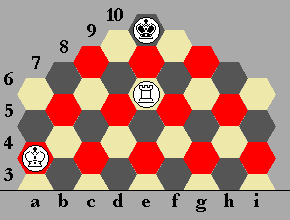 Checkmating
a lone King
Checkmating
a lone King
(By E A Baum, candidate-master of sport in chess.)
 Checkmating
a lone King
Checkmating
a lone King(Queen vs King)
White: Ka4, Qb2 (2);
Black: Ke10 (1).
Checkmate in one move.
1. Qb2-e8×.
 Example
#2
Example
#2(King and Queen vs King)
White: Kd6, Qb2 (2);
Black: Ke10 (1).
Checkmate in two moves.
1. Kd6-e7 Ke10-d9 (or e9) 2. Qb2-e8×.
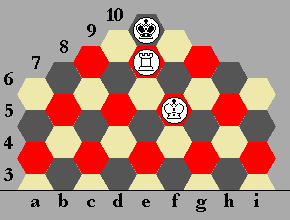 Example
#3
Example
#3(King and Rook vs King)
White: Kf8, Rg5 (2);
Black: Kf10 (1).
Checkmate in two moves.
1. Rg3-g9 Kf10-e10 2. Rg9-e9×.
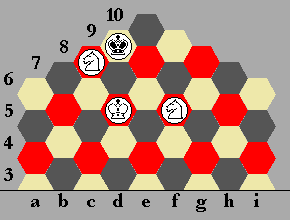 Example
#4
Example
#4(King and two Knights vs King)
White: Kd7, Na5, Ni10 (3);
Black: Ke10 (1).
Checkmate in two moves.
1. Na5-c8 Ke10-d9 2. Ni10-f8×.
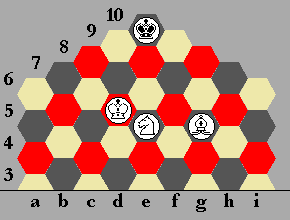 Example
#5
Example
#5(King, Knight and Bishop vs King)
White: Kd7, Nc4, Bi9 (3);
Black: Kd9 (1).
Checkmate in two moves.
1. Nc4-e7+ Kd9-e10 2. Bi9-g8 (or h7)×.
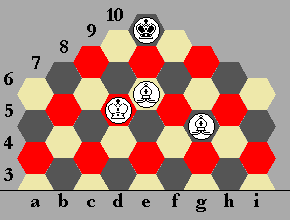 Example
#6
Example
#6(King and two Bishops vs King)
White: Kd7, Bb2, Bd2 (3);
Black: Kd9 (1).
Checkmate in two moves.
1. Bb2-e8+ Kd9-e10 2. Bd2-g8×.
(King and i-Pawn vs King)
White: Ki7, p. i8 (2); Black: Ki9 (1).
If White is to move, the game is drawn:
1. Ki7-h6 Ki9-h8 2. K ~ Kh8:i8
If Black is to move, he loses:
1. ... Ki9-h10 2. Ki7-h8 ~ 3. i8-i9
and the white Pawn is queened.
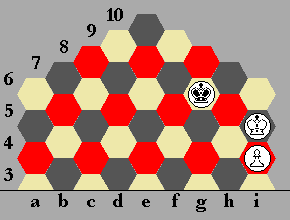 Variant
B:
Variant
B:1. ... Ki9-i10 2. Ki7-h7 Ki10-g9 3. Kh7-i9
See diagram.
3. ... Kg9-g10 4. Ki9-h8 Kg10-h10 5. i8-i9+ ...
1. ... Ki9-g8 2. Ki7-g6 Kg8-i9 3. Kg6-g7 Ki9-i10
After 3. ... Ki9-h10 White wins by 4. Kg7-h8.
4. Kg7-h7 (certainly not Kg7-g8) Ki10-g9 (4. ... Ki10-h10 loses quickly after 5. Kh7-h8) 5. Kh7-i9 etc.
(King and h-Pawn vs King)
White: Kh7, p. h8 (2); Black: Kh9 (1).
If White is to move, Black manages to get into opposition and draw the game by capturing the Pawn or by achieving a repetition of moves:
1. Kh7-g6 Kh9-g8 2. Kg6-i7 Kg8-g7
The same rule of opposition holds true for all other files of the board.
If Black is to move, White can always win:
1. ... Kh7-h10 2. Kh7-i8 Kh10-g8 3. h8-h9 Kg8-h10 4. Ki8-h8 Kh10-f9 5. Kh8-i8
See diagram.
(King and e-Pawn vs King)
White: Ke6, p. e7 (2); Black: Ke8 (1).
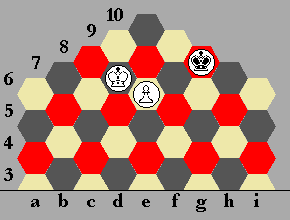 If
Black is to move, White can always win:
If
Black is to move, White can always win:
1. ... Ke8-e9 2. Ke6-c5 Ke9-e8 3. Kc5-c6 Ke8-e9 4. Kc6-c7 Ke9-f10 5. Kc7-d8
5. e7-e8+ won't do because of 5. ... Kf10-e9, getting into opposition and achieving a draw.
5. ... Kf10-g10 6. e7-e8
and the white Pawn is queened. (See diagram.)
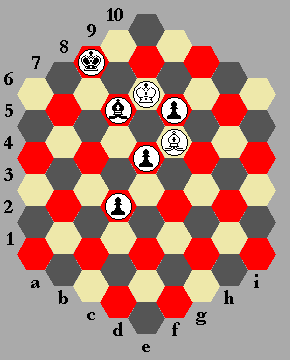 White:
Kd5, Bf7 (2);
White:
Kd5, Bf7 (2);
Black: Kc2, Bb3, pp. d4, e6,
f8 (5).
1. Kd5-e4 Bb3-e9 2. Bf7-d3 Kc2-b3 3. Ke4-d5 Kb3-a4 4. Bd3-f7 Ka4-b6
If Black plays 4. ... Ka4-b3, White repeats his first move, 5. Kd5-e4.
5. Kd5-d6 Kb6-c8 6. Kd6-e8 Be9-d7
and a draw (see diagram).
Or:
3. ... Kb3-c2 4. Kd5-e4
Not 4. Kd5-c4? because of 4. ... Kc2-d2 5. Kc4-e5 f7-f8+. White would have to trade his Bishops for two Pawns and would lose the game.
4. ... Kc2-d1 5. Ke4-f3
and a draw.